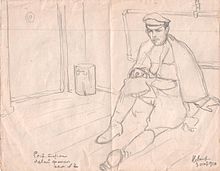Nikolay Lanceray
Nikolay Lanceray | |
|---|---|
 Self-portrait made in 1920, while in Cheka custody at Rostov-on-Don. | |
| Born | Nikolay Evgenievich Lanceray 26 April 1879 |
| Died | 6 May 1942 (aged 63) |
| Nationality | Russian Empire, Soviet Union |
| Occupation | Architect |
Nikolay Evgenievich Lanceray (
Biography
Lanceray was a son of sculptor Eugene Lanceray (senior, 1848–1886) and Yekaterina Benois (daughter of architect Nikolay Benois). His father died when he was six; he and five his siblings were raised by the Benois family and lived most of their childhood at grandfather's Saint Petersburg place. Lanceray completed high school in 1898 and joined the Imperial Academy of Arts, where his illustrious uncle Leon Benois chaired one of three architectural workshops.[1] Lanceray graduated from the Academy in 1904.
In 1903, Lanceray,
From 1925 to 1928, Lanceray and French architect Jessel[
For three following years, Lanceray chaired an architectural workshop on site of Experimental Medicine Institute (Leningrad), collecting pieces of information for his book on Brenna. He was regularly harassed by NKVD searches and interrogations. In May 1938, Lanceray sent the final version of Vincenzo Brenna to the publisher; ten days later he was arrested, again for espionage charges. Lanceray broke down under torture and pleaded guilty; this time, he was sentenced for five years in Kotlas.[6] In 1941, the Kotlas camp was herded, on foot, to Moscow;[7] fellow inmates carried ailing Lanceray on their shoulders. The foot march was followed with rail transport to Saratov; there, Lanceray suffered a heart attack and died on 6 May 1942.[8]
Espionage sentences against Lanceray were lifted posthumously in 1957; first edition of Vincenzo Brenna was published in 2006.[9]
References
- ^ Vityazeva, Modzalevskaya, p. 9
- ^ Vityazeva, Modzalevskaya, p. 11
- ^ Vityazeva, Modzalevskaya, p. 14
- ^ Vityazeva, Modzalevskaya, p. 15
- ^ Vityazeva, Modzalevskaya, p. 16
- ^ Vityazeva, Modzalevskaya, p. 20
- ^ Vityazeva, Modzalevskaya, p. 21
- ^ Vityazeva, Modzalevskaya, p. 22
- ^ Vityazeva, Modzalevskaya, p. 23
Sources
- Vityazeva, V. A., Modzalevskaya, M. A. (2006, in Russian) Istorik russkoy arhitektury Nikolay Lanceray (Историк русской культуры Николай Лансере)
- in: Lanceray, Nikolay (2006). Vincenzo Brenna (Винченцо Бренна) (in Russian). Saint Petersburg: Kolo. ISBN 5-901841-34-4.
- in: Lanceray, Nikolay (2006). Vincenzo Brenna (Винченцо Бренна) (in Russian). Saint Petersburg: Kolo.
